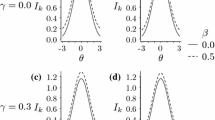Abstract
Under a formula score instruction (FSI), test takers omit items. If students are encouraged to answer every item (under a rights-only scoring instruction, ROI), the score distribution will be different. In this paper, we formulate a simple statistical model to predict the score ROI distribution using the FSI data. Estimation error is also provided. In addition, a preliminary investigation of the probability of guessing correctly on omitted items and its sensitivity is presented in the paper. Based on the data used in this paper, the probability of guessing correctly may be close or slightly greater than the chance score.








Similar content being viewed by others
References
Albano, A. (2014). Package ‘equate’. Retrieved from https://cran.r-project.org/web/packages/equate/equate
Angoff, W. H., & Schrader, W. B. (1984). A study of hypotheses basic to the use of rights and formula scoring. Journal of Educational Measurement, 21, 1–17.
Bliss, L. (1980). A test of Lord’s assumption regarding examinee guessing behavior on multiple-choice tests using elementary school students. Journal of Educational Measurement, 17, 147–153.
Budescu, D., & Bar-Hillel, M. (1993). To guess or not to guess: A decision-theoretic view of formula scoring. Journal of Educational Measurement, 30, 277–291.
College Board. (2015). What new scoring means to you. Retrieved from https://collegereadiness.collegeboard.org/sat/scores/new-scores-meaning-for-students
Durrett, R. (1995). Probability: Theory and examples (2nd ed.). Belmont, CA: Duxbury Press.
Espinosa, M. P., & Gardeazabal, J. (2010). Optimal correction for guessing in multiple-choice tests. Journal of Mathematical psychology, 54, 415–425.
Higham, P. (2007). No special \(K!\) A signal detection framework for the strategic regulation of memory accuracy. Journal of Experimental Psychology: General, 136, 1–22.
Holland, P. W., & Dorans, N. J. (2006). Linking and equating. In R. L. Brennan (Ed.), Educational measurement (4th ed.). Westport, CT: American Council on Education and Praeger Publishers.
Kolen, M. J., & Brennan, R. L. (2004). Test equating, scaling, and linking: Methods and practices (2nd ed.). New York: Springer.
Lord, F. (1980). Applications of item response theory to practical testing problems. Hillsdale, NJ: Lawrence Erbaum Associates.
Lord, F. M. (1983). Maximum likelihood estimation of item response parameters when some responses are omitted. Psychometrika, 48, 477–482.
Lord, F., & Novick, M. (1968). Statistical theories of mental test scores. Oxford, England: Addison-Wesley.
Thorndike, R. L. (Ed.). (1971). Educational measurement. Washington, DC: American Council on Education.
Acknowledgements
The author appreciates the discussions with Shelby Haberman, Neil Dorans, and Michael Walker, and the editorial help from Neil Dorans and Christine Mills. The author is also grateful to Marna Golub-Smith, J. R. Lockwood, Tim Moses, and two anonymous reviewers for insightful comments and diligent review of the manuscript. Any opinions expressed in this publication are those of the author and not necessarily of Educational Testing Service.
Author information
Authors and Affiliations
Corresponding author
Appendices
Appendix
Verification of the assumption in the central limit theorem (CLT) for Proposition 2
In Proposition 2, we used Lyapunov’s theorem (Durrett, 1995).
Theorem 2
Let \(\alpha _n=\{\mathrm{var (S_n)}\}^{1/2}\), where \(S_n=\sum _{i=1}^nX_i\). If there is a \(\delta >0\) so that
then \((S_n-ES_n)/\alpha _n\) converges to a standard normal distribution.
Here we show that the requirement holds in Proposition 2. In Proposition 2, for the group \(\{ R=r\}\), \(X_{r,i}\) is a Bernoulli random variable with a success rate of \(p_{r,i}\) for an examinee i. We omit the subscript r for simplicity. Since there are limited options for each item, the success rate \(1>c_1\ge p_i\ge c_2>0\) holds for some constants \(c_1\) and \(c_2\). For any \(\delta >0\), \(E(|X_i-EX_i|^{2+\delta })= q_i^{2+\delta }p_i+p_i^{2+\delta }q_i\), where \(q_i=1-p_i\). Hence,
where in the last inequality we use the fact that \(p_i\ge c_2\) and \(q_i\ge 1-c_1>0\). Therefore, (5) in Lyapunov’s CLT holds.
Rights and permissions
About this article
Cite this article
Guo, H. Predicting Rights-Only Score Distributions from Data Collected Under Formula Score Instructions. Psychometrika 82, 1–16 (2017). https://doi.org/10.1007/s11336-016-9550-9
Received:
Revised:
Published:
Issue Date:
DOI: https://doi.org/10.1007/s11336-016-9550-9




